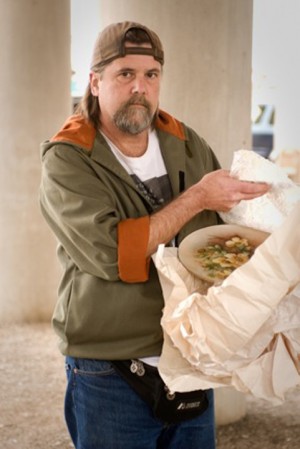
Featured in photography professor Susan Mullally’s book, “What I Keep,” Gary King with his most prized possession, a painted plate.
By Liz Hitchcock
Reporter
Everyone has at some point, been asked the question: If your house suddenly went up in flames and you could only salvage one item, what would you race to save?
The concept for a Baylor photography professor’s most recent book of portraits called “What I Keep” is a lot like this question. Through photographs, Susan Mullally documents underprivileged people and their most valued items.
With an emphasis on archival needs of a frequently overlooked group of people, Mullally addresses how society is accustomed to and often underscores materialistic points of view.
“She loves stories, and the stories the images tell. In this specific project, she is interested in the material things that they’ve kept with them that bears or carries their stories and the meaning of these things,” said Dr. Stephen Sloan, director of the Institute of Oral History. “The stories, or our memories and reminiscences, are the things that bear meaning and identity for us. The stories that are ours and the stories that have been handed down to us from an earlier generation.”
This project was inspired by The Church Under the Bridge and Mullally’s experiences there.
When Mullally moved to Waco in 2007 she decided to join the church. After seeing a request for a photographer to help create a directory for the church, she volunteered her skills towards the endeavor.
“They had never had a directory,” Mullally said. “While doing the headshots I realized it was very important because it was everybody that belonged to the church. [Senior Pastor for The Church Under the Bridge] Jimmy Dorrell always wanted one so he could really get to know everyone and if something happened to someone he would be able to know who wasn’t there.”
After the directory was finished, Mullally, with the help of photographer Gary King, asked the people whose pictures she had taken to bring the items that mean the most to them to church so she could take their portrait.
Although many of the people that attend the Church Under the Bridge are poverty stricken or homeless, they don’t all consider themselves this way.
“One of the guys, who has four different college degrees, Chuck Rose, always says ‘I’m not homeless, I’m houseless’ and I think that’s an important difference,” Mullally said. “They have home and community. There is a real feeling of belonging, but some of them just don’t have houses to live in.”
Each portrait captures a certain sense of humanity, illuminating homelessness and poverty in a more relatable and accessible reality.
Carey Newman, director of publications at Baylor, spoke about Mullallys passion in documenting each individual.
“The depth, the texture, the care and humanity bleeds through every page. The map of the world is on every face. And Susan is able, as both an artist and a compassionate soul, to capture that photographically,” Newman said.
Many people in these photos hold things that we might keep, like a person’s grandmother’s china dishes that she left with them, but other items are things that might even throw away, Mullally said.
“It’s very interesting,” Mullally said. “I’ve learned a lot of things from the people I have met under the bridge.”
Each photograph, in the book and in Mullally’s exhibitions, is accompanied with a quote or short paragraph from the individual explaining their selection, bringing meaning and power to each photo.
“She renders the photos in a way that makes poverty human, and not a social stigma,” Newman said.
The series features 64 portraits, 22 of them currently being shown at the Croft Gallery on Austin Avenue. Forty-five are shown in her recent book, “What I Keep,” that was published by Baylor University Press.
“This is the sort of work that needs to be published and will resonate with a larger audience,” Sloan said. “My role was really appreciating what she had done and taking it to Carey and saying this is something that you need to take a closer look at and something that could possibly go to press.”
When Newman met Mullally to discuss the project, he was immediately taken by her work and after a process of obtaining outside peer reviews for the book, decided to send it to press.
“When she showed up with the photos and she showed up with a notion that she wanted it in print to support her gallery exhibitions,” Newman said, “it didn’t take a rocket scientist to figure out that this would make a great book.”
Virginia Green, design professor, created the cover and designed the layout for the book. She used negative space and simple design to bring attention to the true meaning of the book.
“[Mullally] wanted something very clean,” Green said, “so her content and her subject matter would shine through without a lot of overdesign in the rest of the book.”
Mullally’s goals regarding the series is to create awareness and empathy for people who are less fortunate than most.
“The more people see this work, and the more people that become visible, then the more people aren’t going to be overlooked,” Mullally said.
During the publishing process, Newman said the entire publishing staff was enthusiastic and that they found a book that Baylor could stand behind proudly.
“One of the reasons we’re proud of it is not only the gravity and the passion and the pathos of the images themselves, but the internal moral core of Susan and the book match our university and what the press stands for,” Newman said.






